The War on Tap Water: An Exclusive Excerpt from Peter Gleick’s Bottled and Sold
Monday marked the release date of Pacific Institute President Peter Gleick’s latest book, Bottled and Sold: The Story Behind Our Obsession with Bottled Water–the latest, loud voice added to a growing chorus of tap water defenders. Almost nine billion gallons of bottled water were packaged and sold in the U.S. in 2008, with 40 billion being sold globally that same year, according to Gleick’s findings. The MacArthur fellow uses his words as a wake up call for the industrialized nations that take their safe, affordable drinking water for granted. Instead of focusing on the figures, Gleick takes a look at how we commodified one of the world’s most precious resources, highlighting the campaigns implemented by bottling companies.
By Peter Gleick
Special to Circle of Blue, ©2010
—A flyer touting the stock of a Texas
bottled water company.
“When we’re done, tap water will be relegated to showers and
washing dishes.”
—Susan Wellington, president of the Quaker Oats
Company’s United States beverage division.
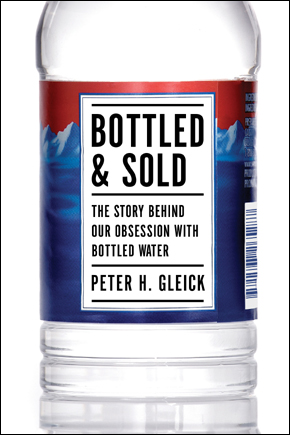
September 15, 2007, was a big day for the alumni, family, and fans of the University of Central Florida and the UCF Knights football team. After years of waiting and hoping, the University of Central Florida had finally built their own football stadium—the new Bright House Networks arena. Under clear skies, and with temperatures nearing 100 degrees, a sell-out crowd of 45,622 was on hand to watch the first-ever real UCF home game against the Texas Longhorns, a national powerhouse. “I never thought we’d see this, but we sure are proud to have a stadium on campus,” said UCF alumnus and Knight fan Tim Ball as he and his family tailgated in the parking lot before the game. And in an exciting, three-hour back-and-forth contest, the UCF Knights almost pulled off an upset before losing in the final minutes 35 to 32.
Knight supporters were thrilled and left thirsting for more–literally. Fans found out the hard way that their new $54-million stadium had been built without a single drinking water fountain. And for “security” reasons, no one could bring water into the stadium. The only water available for overheated fans was $3 bottled water from the concessionaires or water from the bathroom taps, and long before the end of the game, the concessionaires had run out of bottled water. Eighteen people were taken to local hospitals and sixty more were treated by campus medical personnel for heat-related illnesses. The 2004 Florida building code, in effect in 2005 when the UCF Board of Trustees approved the stadium design, mandated that stadiums and other public arenas have a water fountain for every 1,000 seats, or half that number if “bottled water dispensers” are available. Under these requirements, the arena should have been built with at least twenty water fountains. Furthermore, a spokesman for the International Code Council in Washington, which developed Florida’s building code, said, “Selling bottled water out of a concession stand is not what the code meant.”
The initial reaction from the University was swift and remarkably unapologetic: UCF spokesman Grant Heston appeared on the local TV news to argue that the codes in place when the stadium was designed didn’t require fountains. A few days after the game, as news of the hospitalizations was reverberating, University President John Hitt said, “We will look at adding the water fountains, but I have to say to you I don’t think that’s the answer to this problem. We could have had 50 water fountains and still had a problem on Saturday.”2 Al Harms, UCF’s vice president for strategic planning and the coordinator for the operations of the stadium, told the Orlando Sentinel, “We won’t make a snap decision” about installing fountains in the new stadium. Harms did promise that they would triple the amount of bottled water available for sale, and give away one free bottle per person at the next game.3 Harms also said, apparently without a trace of sarcasm, “It’s our way of saying we’re sorry.”
For some UCF students, this wasn’t enough. One of them, Nathaniel Dorn, mobilized in twenty-first-century fashion. He created a Facebook group, Knights for Free Water, which quickly attracted nearly 700 members. He and several other students showed up at a packed school hearing, talked to local TV and print media, and ridiculed the school’s offer of a free bottle of water. Under this glare of attention the University did an abrupt about-face and announced that ten fountains would be installed by the next game and fifty would be installed permanently.
All of a sudden public water fountains have vanished and bottled water is everywhere: in every convenience store, beverage cooler, and vending machine. In student backpacks, airplane beverage carts, and all of my hotel rooms. At every conference and meeting I go to. On restaurant menus and school lunch counters. In early 2007, as I waited for a meeting in Silicon Valley, I watched a steady stream of young employees pass by on their way to or from buildings on the Google campus. Nearly all were carrying two items: a laptop and a throw-away plastic bottle of water. When I entered the lobby and checked in at reception, I was told to help myself to something to drink from an open cooler containing fruit juices and rows of commercial bottled water. As I walked to my meeting, I passed cases of bottled water being unloaded near the cafeteria.
Water fountains used to be everywhere, but they have slowly disappeared as public water is increasingly pushed out in favor of private control and profit. Water fountains have become an anachronism, or even a liability, a symbol of the days when homes didn’t have taps and bottled water wasn’t available from every convenience store and corner concession stand. In our health-conscious society, we’re afraid that public fountains, and our tap water in general, are sources of contamination and contagion. It used to be the exact opposite—in the 1800s, when our cities lacked widespread access to safe water, there were major movements to build free public water fountains throughout America and Europe.
In London in the mid-1800s, water was beginning to be piped directly into the homes of the city’s wealthier inhabitants. The poor, however, relied on private water vendors and neighborhood wells that were often broken or tainted by contamination and disease, like the famous Broad Street pump that spread cholera throughout its neighborhood. At the time of London’s Great Exhibition in 1851, conceived to showcase the triumphs of British technology, science, and innovation, Punch Magazine wrote: “Whoever can produce in London a glass of water fit to drink will contribute the best and most universally useful article in the whole exhibition.”4 Just three years after the Exhibition, thousands of Londoners would die in the third massive cholera outbreak to hit the city since 1800.
By the middle of the twentieth century, spectacular efforts to improve water-quality treatment and major investments in modern drinking-water systems had almost completely eliminated the risks of unsafe water. Those of us who have the good fortune to live in the industrialized world now take safe drinking water entirely for granted. We turn on a faucet and out comes safe, often free fresh water. Notwithstanding the UCF stadium fiasco, we’re rarely more than a few feet from potable water no matter where we are. But those efforts and investments are in danger of being wasted, and the public benefit of safe tap water lost, in favor of private gain in the form of little plastic water bottles.
The growth of the bottled water industry is a story about 21st century controversies and contradictions: poverty versus glitterati; perception versus reality; private gain versus public loss. Today people visit luxury water “bars” stocked with bottles of water shipped in from every corner of the world. Water “sommeliers” at fancy restaurants push premium bottled water to satisfy demand and boost profits. Airport travelers have no choice but to buy bottled water at exorbitant prices because their own personal water is considered a security risk. Celebrities tout their current favorite brands of bottled water to fans. People with too much money and too little sense pay $50 or more for plain water in a fancy glass bottle covered in fake gems, or for “premium” water supposedly bottled in some exotic place or treated with some magical process.
In its modern form, bottled water is a new phenomenon, growing from a niche mineral-water product with a few wealthy customers to a global commodity found almost everywhere. The recent expansion of bottled water sales has been extraordinary. In the late 1970s, around 350 million gallons of bottled water were sold in the United States—almost entirely sparkling mineral water and large bottles to supply office water coolers—or little more than a gallon and a half per person per year. As the figure below shows, between 1976 and 2008, sales of bottled water in the United States doubled, doubled again, doubled again, and then doubled again. In 2008, nearly 9 billion gallons (over 34 billion liters) of bottled water were packaged and sold in the United States and five times this amount was sold around the world, feeding a global business of water providers, bottlers, truckers, and retailers at a cost to consumers of over a hundred billion dollars.
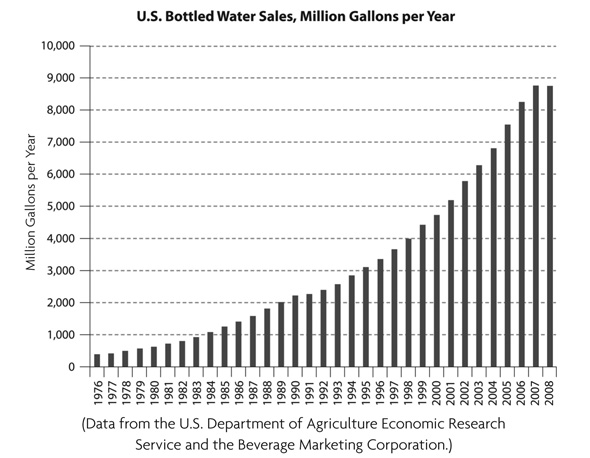
Americans now drink more bottled water than milk or beer—in fact, the average American is now drinking around 30 gallons, or 115 liters, of bottled water each year, most of it from single-serving plastic containers. Bottled water has become so ubiquitous that it’s hard to remember that it hasn’t always been here. As I write this sentence I’m sitting in the café in the basement of the capitol building in Sacramento, California, and all I have to do is lift my eyes from my computer screen—right in front of me are vending machines selling both Dasani and Aquafina. Yet, like UCF football fans, I can’t tell you where the nearest water fountain is.
Millions of Americans still drink tap water at home and in restaurants. But there is a war on for the hearts, minds, and pocketbooks of tap water drinkers, a huge market that water bottlers cannot afford to ignore. The war on the tap is an undeclared war, for the most part, but in recent years, more and more subtle (and not so subtle) campaigns that play up the supposed health risks of tap water, or the supposed health advantages of bottled water, have been launched by private water bottlers.
How do you convince consumers to buy something that is essentially the same as a far cheaper and more easily accessible alternative? You promote perceived advantages of your product, and you emphasize the flaws in your competitor’s product. For water bottlers this means selling safety, style, and convenience, and playing on consumer’s fears. Fear is an effective tool. Especially fear of sickness and of invisible contamination. If we can be made to fear our tap water the market for bottled water skyrockets.
I guess I shouldn’t have been surprised, therefore, when I opened my mailbox and found a flyer with a cover image of a goldfish swimming in a glass of drinking water. “There is something in this glass you do not want to drink. And it’s not the fish,” shouted the bold and colorful text in the mailer, offering me home delivery of bottles of Calistoga Mountain Spring Water. “How can you be sure your water is safe? Take a closer look at the water in our glass. Can you tell if it’s pure? Unfortunately, you can’t.” And the solution offered? The “Path to Purity” lies with bottles of water, delivered to your door by truck, under a monthly contract.
“Tap water is poison!” declares another flyer my neighbor Roy received in the mail in early 2007 touting the stock of Royal Spring Water Inc., a Texas bottled water company. “Americans no longer trust their tap water. . . . Clearly, people are more worried than ever about what comes out of their taps.” Roy, a thoughtful guy, told me he was actually more worried about what came out of his mailbox than his tap. The website of another bottler says, “Tap water can be inconsistent. . . . The U.S. Environmental Protection Agency has reported that hundreds of tap water sources have failed to meet minimum standards.”
These attacks could be dismissed as the inappropriate actions of a few small players, except that some of the world’s biggest bottlers have also targeted tap water. In 2000, shortly before he was made chairman of PepsiCo’s North American Beverage and Food division, Robert S. Morrison publicly declared, “The biggest enemy is tap water. . . . We’re not against water—it just has its place. We think it’s good for irrigation and cooking.” That same year, Susan Wellington, president of the Quaker Oats Company’s United States beverage division, candidly told industry analysts, “When we’re done, tap water will be relegated to showers and washing dishes.” “We need to change the way we sell water,” said industry analyst Kathleen Ransome at the 2006 International Bottled Water Association annual convention in Las Vegas. “At what point will consumers turn to the tap?”
Subtler advertising approaches also play on our fears. PepsiCo hired actress Lisa Kudrow to promote Aquafina with the phrase “So pure, we promise nothing” in a campaign Brandweek magazine jokingly called the “Nothing” campaign.9 Kinley in India offers “Trust in every drop,” while another Indian bottler, Bisleri, advertises “Bisleri. Play safe.”
Officially, the large bottled water industry associations advise their members to refrain from attacks on tap water. Some bottled water companies have signed up to the International Bottled Water Association’s voluntary code of advertising, “which encourages members not to disparage tap water.”10 Alas, as Captain Barbossa notes in the popular movie Pirates of the Caribbean, “the code is more what you’d call ‘guidelines’ than actual rules,” and even the bottled water associations cannot resist making critical comments about tap water. “The difference between bottled water and tap water is that bottled water’s quality is consistent,” said Stephen Kay, IBWA spokesman in May 2001, implying, of course, that tap water quality isn’t and thus worse.11 In 2002, Kay said, “Some people in their municipal markets have the luxury of good water. Others do not.” Similarly, the website of the Australasian Bottled Water Association pokes barbs at tap water, saying, “Some people also wish to avoid certain chemicals used in the treatment of public water supplies, such as chlorine and fluoride, and are therefore turning to the chemical-free alternative.”
In the fall of 2007 I attended the IBWA annual convention in Las Vegas. Las Vegas is a pretty incongruous place to hold a bottled water convention. Planted in the heart of one of the driest regions in the United States, it has very limited access to water. Yet the IBWA’s major social event is a golf tournament played on waterintensive grass that consumes precious, limited water. The bottled water convention itself is a cross between a pep rally, a political campaign meeting, and a how-to seminar for individuals hoping to cash in on the bottled water craze. I wandered from session to session, from discussions of marketing strategies to closed-door meetings on how to deal with new regulatory efforts by federal agencies. I listened to talks on how to counter the efforts of anti–bottled water activists and watched demonstrations of the latest machines for bottling water. The culmination of the convention was the keynote presentation of Fred Smith, president of the Competitive Enterprise Institute, which promotes a libertarian, free-market agenda.14 Smith extolled the virtues of a world where business entrepreneurs could make money selling water in bottles. The problem, Smith told me afterward, without a hint of irony, was that water “suffers most from being treated as a common property resource.” Smith believes that “water policy could benefit greatly from exploring the strategies that have been used to produce oil.”
It is this belief that water is fundamentally no different than oil or any other private commodity that lies at the heart of the controversy over selling water. A few months after the IBWA convention, Smith’s Competitive Enterprise Institute launched a special project called “Enjoy Bottled Water” in which they criticize the safety of tap water, ridicule opponents of bottled water, and promote the industry’s merits. “Bottled water is substantially different from tap water,” the CEI website declares. “When compared to bottled water, risks appear to be somewhat higher for tap water. . . . Available data indicates that bottled water has a better safety record.” The CEI is so ideologically anti-regulation that the site says, “The fact that anyone would want to ban or regulate a healthy and safe option like bottled water is really absurd.” It may come as no surprise to note that Coca-Cola, maker of Dasani bottled water, was the largest single supporter of CEI’s annual fundraising dinner in 2008.
The campaign against municipal tap water has been more than just words. In 2001, documents found on a Coca-Cola company website revealed that it had a formal program to actively discourage restaurant customers from drinking tap water. Working with the Olive Garden restaurant chain, Coca-Cola developed a six-step program to help the restaurant reduce what they call “tap water incidence”—the unprofitable problem of customers drinking tap water rather than ordering revenue-producing beverages. “Some 20 percent of consumers drink tap water exclusively in Casual Dining restaurants,” the program lamented. “This trend significantly cuts into retailer profits. . . . Research was conducted to better understand why tap water consumption is so prevalent and why consumers are making this beverage choice. . . . This research provides the valuable insight and understanding needed to convert water drinkers to profit-producing beverages.”
These documents, very quickly pulled from official websites when the media picked up the story, had already been downloaded and reposted elsewhere. “This is awesome,” commented one reader. “It’s what corporations say to each other behind customers’ backs, only it happens to be on the Web where mortals can see it.” It isn’t just bottled water companies that have tap water in their sights. Full-service restaurants have recognized the profit-generating potential of bottled water. Servers in restaurants operated by the Omni Hotels and Resorts, for example, are trained to describe “the characteristics of the waters being offered and are also trained to approach the table with chilled bottles of water. They offer it to the guest as an option to tap water,” according to Fernando Salazar, corporate director of the food and beverage division in 2006. “It’s just part of the server’s presentation to offer bottled water first before offering tap water,” says Salazar. “Those restaurants that are not yet doing this are missing an opportunity to increase profits.”
Brita, a subsidiary of the Clorox Company that sells home water filters, has also been particularly aggressive in maligning tap water, which is their direct competitor in the home market. One of Brita’s advertising campaigns claimed that a Brita filter “turns tap water into drinking water.” Other Brita ads say, “We’d like to clear up a few things about tap water.” “Tap water becomes wonderful water.” “Too often, impurities are finding their way into the water. While you may not be able to see them, you don’t want them.”21 One of Brita’s television ads aired in the United States and Canada took a particularly graphic approach, with the camera focused on a glass of water in a kitchen. Viewers watch the glass drain and then refill to the background sound of a flushing toilet. Superimposed on the image were the words “Tap and toilet water come from the same source,” and the voice-over at the end of the commercial asked viewers: “Don’t you deserve better?” In the magazine version, the advertising copy read, “You deserve better than the water you mop with.”
These efforts sparked the ire of both the American Water Works Association, which represents municipal water agencies, and its Canadian counterpart. The Associations publicly objected to Brita’s “unsavory tactics” and called on Brita to cancel the commercials. Advertising Standards Canada, which regulates advertising, received eleven formal complaints and after reviewing the ads ruled that they “conveyed an inaccurate representation of a product/service/ commercial activity; omitted relevant information; unfairly demeaned, disparaged, and discredited another product/service/commercial activity (i.e., municipally supplied water); and misled consumers by playing upon their fears of the safety of drinking water.”
Looking at the massive growth in bottled water consumption, it is apparent that the bottled water companies have been winning the war against tap water. And in one of their latest campaign tactics, the bottled water industry is now arguing in debates, Congressional testimony, advertising, and media campaigns that the growth of bottled water sales doesn’t come at the expense of tap water, but rather other commercial beverages. In 2003, Stephen Kay, spokesman for the International Bottled Water Association, told E—The Environmental Magazine that “bottled water’s competition is soft drinks, not tap water.”24 In 2006, he told the Chicago Tribune’s “Morning Call” column that “bottled water’s competition is not your faucet but the soft drinks, juices, sport drinks, and teas that people buy while they’re on the go.”
The industry continues to push this argument. In August 2007, they bought full-page ads in the New York Times and other papers. “Whether it comes from a faucet or a bottle, drinking water is an easy step people can take to lead a healthier lifestyle. So, as far as we’re concerned, the drink in everyone’s purse, backpack, and lunch box should be water.” In December 2007, in testimony to the U.S. Congress, the IBWA President, Joe Doss, said, “Consumers also choose bottled water over other beverages because it does not contain calories, caffeine, sugar, artificial flavors or colors, alcohol and other ingredients.”26 Bottled water consumption is good, the industry argues, because the growth of bottled water sales has come not at the expense of tap water, but of other beverages.
This is an intriguing and potentially powerful argument, except that it is false. After hearing the industry repeat this claim over and nover, I went and looked up the actual numbers. Are we really drinking bottled water instead of soft drinks and other consumer beverages, as the industry argues, or are we actually drinking less tap water? The U.S. Department of Commerce collects and publishes excellent data on beverage consumption. Contrary to what the bottled water industry argues, the numbers show that we are buying more bottled water and carbonated soft drinks, and drinking less of everything else, including milk, coffee, tea, fruit juices, beer, wine, hard alcohol, and especially tap water.
The graph below clearly shows the growth in consumption of both soft drinks and bottled water at the expense of everything else we drink. Indeed, between 1980 and 2006, data on beverage consumption reveals that on average, each of us is actually drinking around 36 gallons per year less tap water now. With what have we replaced this water? Soda and bottled water. Over this same period of time, our consumption of carbonated soft drinks has grown by 17 gallons per person per year, our consumption of bottled water has grown by 25 gallons per person per year, and our purchases of all other beverages, including milk, juices, beer, tea, coffee, and hard liquor have dropped by 6 gallons per year.
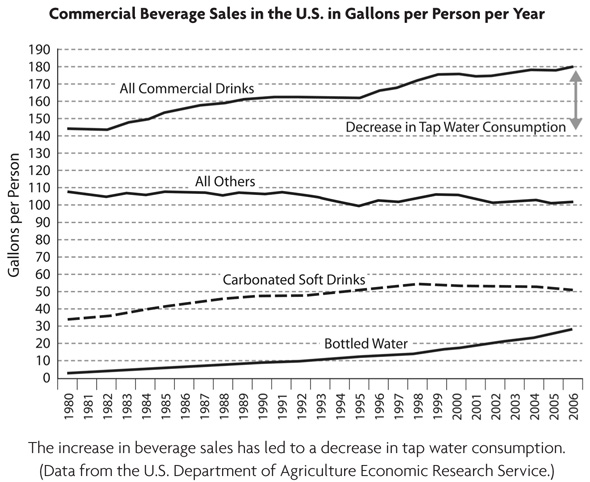
The beverage companies are winning the war on tap water. As long as people can be made to fear tap water, they will seek out alternatives they think offer more safety. But we have to ask: is bottled water actually any safer? What do we know about what’s actually in our tap water—or in the bottles of water we buy? And how safe is it to drink?
The above excerpt is the first chapter from MacArthur fellow Peter Gleick’s new book, Bottled and Sold, published by Island Press this month.
Circle of Blue provides relevant, reliable, and actionable on-the-ground information about the world’s resource crises.

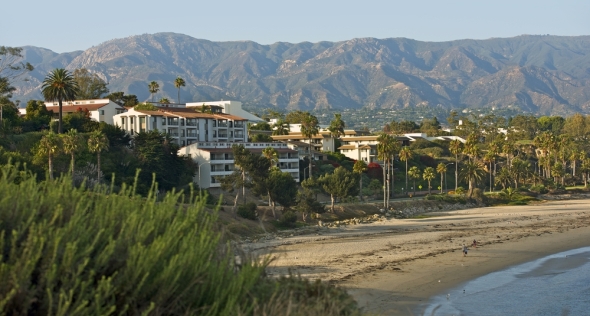


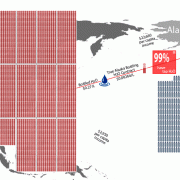




A great solution is Hydros Bottle. It is a water bottle with a built in filter. They are trying to reduce the environmental impact of bottled water. Also, some profits from each bottle sold go towards getting clean water to villages without it.
Help spread the word and support our cause on Facebook at: http://www.facebook.com/hydrosbottle